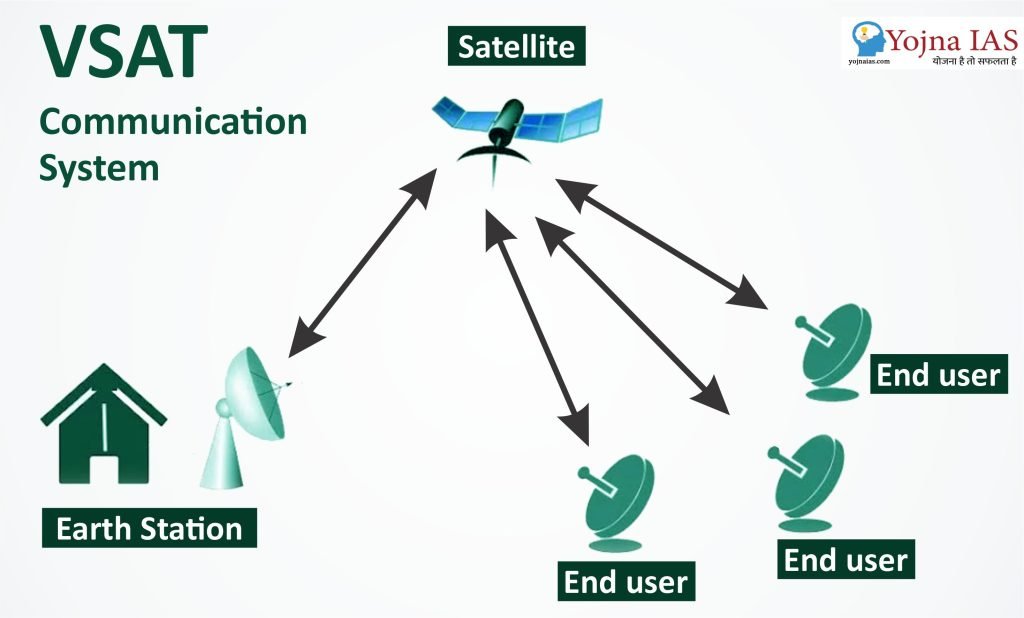09 Mar 2024 ISRO to deploy V-SAT stations in 80 tribal communities
This article covers ‘Daily Current Affairs’ and the topic details of ”ISRO to deploy V-SAT stations in 80 tribal communities”.This topic is relevant in the “Science and Technology” section of the UPSC CSE exam.
Why in the News?
The Ministry of Tribal Affairs intends to work with the Indian Space Research Organisation (ISRO) to deploy V-SAT stations in approximately 80 tribal communities in Jharkhand, Madhya Pradesh, Odisha, and Maharashtra as a pilot project to provide Internet access.
More about the News
- A government assessment by the Ministry of Tribal Affairs revealed that nearly 18,000 tribal villages across India face significant connectivity issues due to their remote locations and challenging terrain. This lack of access to mobile and internet networks hinders these communities’ ability to access essential services.
- To address the network problem, a pilot program is being launched to install V-SAT stations in 80 tribal villages located in Jharkhand, Madhya Pradesh, Odisha, and Maharashtra. These villages are among the most geographically isolated and have difficult terrain, making traditional connectivity solutions impractical.
- ISRO’s V-SAT technology, which utilises satellites for communication, offers a promising solution to bridge this connectivity gap. The V-SAT stations can be either fixed or mobile, providing flexibility for deployment. These stations will deliver Wi-Fi with a capacity of 100 Mbps, with the potential to be doubled using boosters. This enhanced connectivity will significantly improve access to essential services for these tribal communities.
Bridging the Gap: How V-SAT Connectivity Can Empower Tribal Communities
The rollout of ISRO’s V-SAT internet solution holds immense potential to transform the lives of tribal communities in remote areas. This initiative is expected to act as a catalyst for development and inclusion by delivering a range of benefits:
- Education: Enhanced access to quality education through e-learning platforms, digital libraries, and virtual classrooms.
- Healthcare: Improved healthcare delivery via telemedicine consultations, remote diagnostics, and online consultations with specialists.
- Government Services: Increased participation in government programs and easier access to services through user-friendly digital platforms.
- Economic Empowerment: A boost to local entrepreneurship and economic activities through digital payment systems, e-commerce opportunities, and wider market reach.
- Youth Development: Equipping tribal youth with valuable digital skills and opening doors to new employment opportunities in the digital economy.
About Very Small Aperture Terminal (VSAT):
- A Very Small Aperture Terminal, or VSAT, is a bidirectional ground station designed to transmit and receive data to and from satellites. Standing at less than three metres in height, a VSAT is capable of handling both narrow and broadband data, establishing real-time communication with satellites in orbit. The transmitted data can be redirected to various remote terminals or hubs across the globe.
- Beyond its technical aspects, VSAT networks offer significant benefits for various commercial applications. One of the most prominent examples lies in Enterprise Resource Planning (ERP) systems. Retail giant Walmart serves as a prime example. They utilised VSAT technology for real-time inventory tracking. This innovation enabled Walmart to:
- Effectively Manage Vast Inventory: VSAT provided real-time data, allowing for precise stock management across their extensive network.
- Reduce Delivery Costs: By optimising delivery routes based on accurate inventory levels, Walmart minimised unnecessary transportation expenses.
- Streamline Inventory Movement: The combination of VSAT and a centralised hub system reduced the number of times products needed to be moved before reaching store shelves.
- Similarly, manufacturers leverage VSAT for functionalities typically reliant on wired networks. These include:
- Order Relay: VSAT facilitates the rapid transmission of orders from various locations.
- Real-time Production Monitoring: Manufacturers can gain instant insights into production figures, allowing for adjustments and optimisation.
- Enhanced Communication: VSAT enables efficient communication channels for various business operations.

Advantages of VSAT
Infrastructure Independence: Unlike traditional wired networks that rely on cables and physical connections, VSATs utilise satellite signals. This eliminates the need for extensive infrastructure development, reducing the risk of damage caused by structural issues.
Backup for Wired Networks: VSAT systems can operate independently, serving as a reliable backup for existing wired networks in case of outages or failures. This ensures uninterrupted communication during critical situations.
Easy Deployment in Remote Areas: Traditional wired networks can be challenging to install in remote locations. Here, VSAT shines. With minimal infrastructure requirements, VSATs can be readily deployed, enabling connectivity even in the most isolated regions. Satellite signals can be directed to various locations through a central hub, further enhancing accessibility.
Disadvantages of VSAT
Latency Issues: Due to the distance data travels between satellites and Earth stations, VSATs experience a delay in signal transmission (latency). This can be particularly noticeable in real-time, two-way communication situations, such as video conferencing.
Weather and Obstruction Dependency: Heavy rain, snow, or strong winds can disrupt satellite signals, leading to temporary connectivity issues. Additionally, physical obstructions like buildings or trees can also cause signal distortion, affecting data transmission quality.
Download Yojna daily current affairs eng med 9th March 2024
Prelims practise questions
Q1. What are the potential benefits of the V-SAT initiative for tribal communities?
(a) Improved farming techniques
(b) Enhanced digital skills for tribal elders
(c) Increased access to essential services like healthcare and education
(d) Restricted economic activities
Answer: C
Main practise question
Q1. Discuss the potential benefits of the V-SAT initiative for tribal communities, focusing on its impact on education, healthcare, government services, and economic empowerment.
I am a content developer and have done my Post Graduation in Political Science. I have given 2 UPSC mains, 1 IB ACIO interview and have cleared UGC NET JRF too.


No Comments